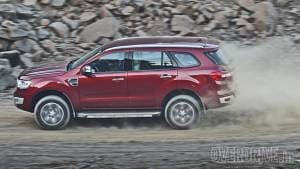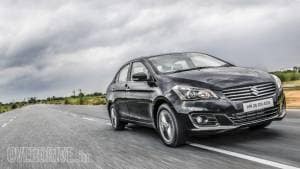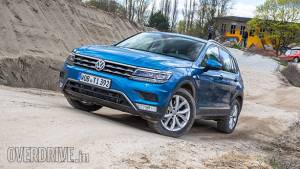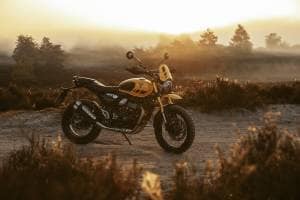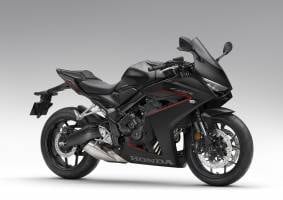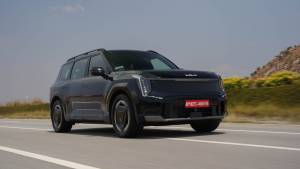Track test: TVS Apache RTR 200 4V vs KTM 200 Duke vs Bajaj Pulsar RS 200
As soon as we tasted TVS' new Apache RTR 200 4V at the manufacturer's test track in Hosur we knew we wanted to bring the bike to the racetrack and setup a battle with the bikes it challenges. That would be the KTM 200 Duke, which is excellent at the track and the Bajaj Pulsar RS200, which might suggest that the designers were paid by the line but is the most dynamic Pulsar of all.
And so one weekend, a shiny yellow RTR 200 4V was waiting at the Kari Motor Speedway for us. Since the new Apache 200 has a gazillion variants, let's clarify. The one we have is the fuel injected one with Pirelli tyres. Until the ABS versions come, at Rs 1.07 lakh (ex-Delhi) this is the most expensive one. To set its context, the KTM 200 Duke is priced at Rs 1.38 lakh. It has the same equipment as the RTR - fuel injection. While the stock Duke comes with excellent MRF Revz tyres, this one, strangely enough had Metzelers mounted, most likely by the dealer. That's an added Rs 17,000 to the base price. The Bajaj Pulsar RS200 is priced at Rs 1.32 lakh. Ours was the front-only ABS version. Let's get straight into it.
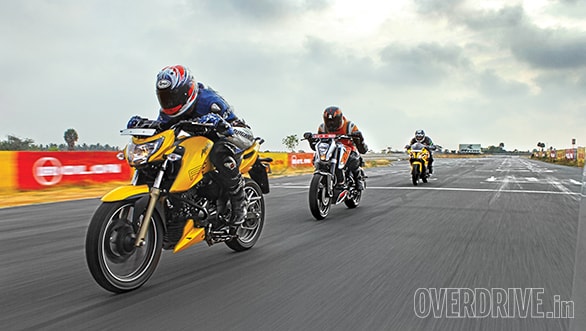
Straight line performance
The bikes are pretty evenly matched all things considered. The Duke is very interesting because it revs out smoothly, appears to have the same torque everywhere and you just feed it gears until it gets to about 137kmph. Then the limiter cuts in violently and lops a full 4kmph off the top. At Kari, fast riders will cycle between an indicated 137 and 133kmph a full three times before braking for turn one. It's not fun. Rishaad discovered from another 200 Duke owner that if you roll the throttle back smartly and stabilise at 136kmph, the limiter issues can be averted.
The RS200's engine isn't as fast outright but it's a more interesting engine to ride with in some ways. Unlike the Duke, the RS200 seems to have a more linear and perceptible ramp up in torque as the revs rise. It just feels more natural to ride than the 200 Duke though it isn't quite as quick down Kari's long straight.
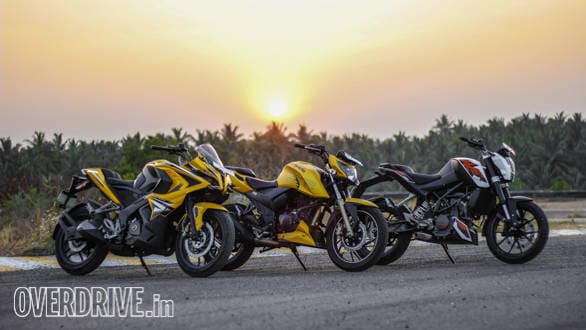
The TVS couldn't be more different. If you remember, the company had clearly stated that they tuned the bike for midrange because that's what you need on the street. The RTR 200 consequently, feels very gutsy in the mid revs. But down the straight you realise that the top-end performance isn't in the same league. It will hit the same 138kmph as the Duke but it happens a lot further down the road.
We would go further and say that the 0.68 second gap to the RS200's lap time comes down to that difference in performance at the end of Kari Motor Speedway's long straight. A small gap considering the RTR's lower power. The Pulsar has more power and torque but the fact that it is carrying 16.5kg over the TVS works against it on a tight track like Kari. Goes to show how important weight saving can be even on small motorcycles.

All three engines are pretty good in terms of refinement. But the Duke is clearly the least refined. It's got a subtle but persistent vibration that you notice in this company. It's not annoying and it won't buzz your hands at this track where high speeds are experienced again and again but only for short intervals.
But the RS200's engine is smoother. It's got a sense of mechanical cohesion about it that produces a smoother, more together feel than any other Pulsar. Strangely enough, the RS200 is very rough and clattery at idle but smooths out dramatically as the revs rise.
The Apache is the best by a fair margin. It's so smooth that it almost feels like the engine parts are coated in soft-touch materials rather than metals. It's very impressive that the TVS controls its vibration so tightly even going flat out.
Braking
The KTM Duke range's weakest link has been the brakes. They're limp and flaccid and a lot of lever travel must occur before braking happens. Our test bike, clearly, was not informed of this. We've never tested a Duke with such strong and progressive brakes! What a pleasant surprise! The stiffer suspension and the strong brakes combine to offer terrific braking on the 200 Duke.
Going from top speed to about 90kmph for the the first turn, the Duke is the bike where we braked the latest and hardest. However, given our extensive experience with 200 Duke brakes, I have to put this performance down to an exceptionally good unit rather than the norm.
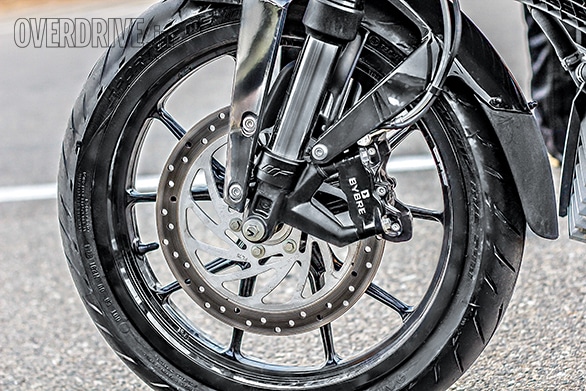
The RS200 front wheel has the only ABS unit here and it makes it easy to lean extra hard on it. However, we would be happier if the Pulsar's brakes offered a lot more feel and just a little bit more initial bite. There is strong dive but the stable chassis allows you to not get it all unsettled.
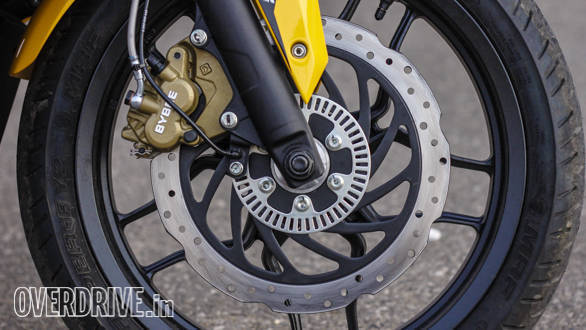 The Bajaj Pulsar RS 200 is the only bike with single channel ABS
The Bajaj Pulsar RS 200 is the only bike with single channel ABS
The Apache doesn't (yet) have ABS but it does have a solid set of brakes. I loved the bite and progression as well as the feedback. I would probably have asked for slightly more bite again but the suspension will probably not like it. As it stands, the softer overall setup produces quite a bit of dive on the brakes and more bite will bring the bike uncomfortably close to bottoming the fork out which is never a good thing.

There were two places at Kari where strong braking produced a soft pogo-ing suspension movement. The Honda CBR250R has a very pronounced pogo that forces you to wait for stability before you can steer the bike. The Apache's facsimile is very gentle and I found that I didn't really have to delay the steering input because of it. I suspect that a slightly better damped setup would be better for full pace riding - though that's clearly not a major agenda for the street focussed RTR.
Turn in
This is a good, trustworthy bunch of motorcycles. Really good to learn on, even. The Apache is by far the friendliest. Steering inputs produce a natural, neutral turn in and it's easy to turn as hard as you like. There is a point though where a quick hard steering input can cause a transient moment of worry and you really need to expect this and be prepared to instantly open just a little bit of throttle to take weight off the front and stabilise the motorcycle. Part of this is the soft setup that exaggerates the effects of weight transfer and part is a slight mismatch in grip between rear and front tyres that manifests in times like this. The TVS Remora tyres on the lower variants might not offer as much outright grip, but I suspect that they'll be more fluent because of a better match between front and rear grip.
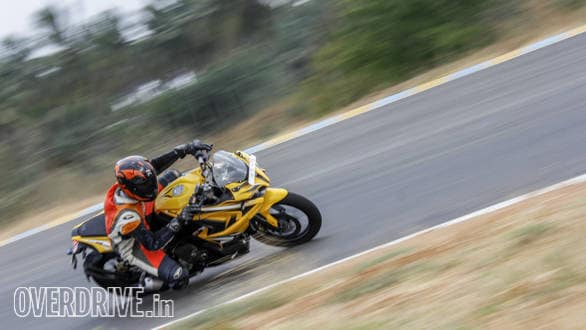 The RS200's very busy looking fairing provides the best wind protection and it boasts the most track friendly riding position. The brakes could do with a lot more bite but the MRF Revz tyres perform well. Triple spark engine feels least refined at idle and smoothest at the redline!
The RS200's very busy looking fairing provides the best wind protection and it boasts the most track friendly riding position. The brakes could do with a lot more bite but the MRF Revz tyres perform well. Triple spark engine feels least refined at idle and smoothest at the redline!
What the RTR clearly doesn't like are chicanes where you flick from full lean on one side to the other. Here, the bike wants you to get back on the gas and stabilise as fast as possible. I'd love to ride a TVS Remora-shod RTR to see if it's the chassis, or more likely, the grip mismatch between the Pirellis.
The Pulsar RS200 initially feels slower to respond than the Apache. But it's an illusion. The RS200, despite having a shorter wheelbase than the Duke has a considerably longer trail and this gives it the feeling of stability. More stable means more effort is needed to change course. Amp up the inputs and the RS200 is a star. It turns fast and accurate and it's suspension is up for a quick, hard lean angle. The feel of the suspension isn't as classy as the Apache but it's on the ball even after the pace is well and truly fast.
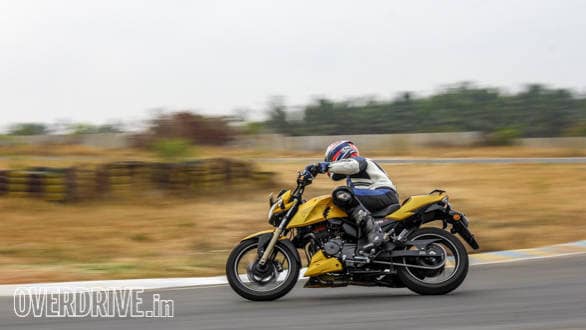 TVS' brand new, four valve engine in the RTR 200 has been tuned for midrange grunt which is great on the street but leaves the top end a little lacking on the track. The Apache offers strong brakes with just the right amount of bite so as to not upset the soft-ish chassis. The exhaust scrapes but only on the very limit
TVS' brand new, four valve engine in the RTR 200 has been tuned for midrange grunt which is great on the street but leaves the top end a little lacking on the track. The Apache offers strong brakes with just the right amount of bite so as to not upset the soft-ish chassis. The exhaust scrapes but only on the very limit
The Duke is, by far, the best of the lot. It's design robs you of space to sit and move about. It's a really slippery motorcycle when it comes to anchoring the outer leg to the tank for cornering. But what reflexes! The stiff chassis and suspension and the inherently stiffer front (thanks USD forks) produce clean, hard, predictable turn ins. Aggressive tyre profiles also allow the Duke to almost literally fall to deep lean angles. It takes some getting used to but the KTM is hard charging and very, very responsive. It's aggressive enough to initially scare new riders but once you've tasted its peculiarly sharp tang, it's hard to accept anything less responsive.
Mid corner
The KTM acquires lean so easily that you run up against clearance problems very rapidly. Jacking the preload up can stave off the peg scraping but it's a sign of how aggressive the setup is more than anything else. Changing lines or mid-corner corrections aren't hard to accomplish either because despite feeling very light, the KTM is stable at heavy lean. If there's one point the Metzelers shine, its here where the extra grip boosts confidence to trail brake right upto the apex. I'd say the benefit from the non-OE tyres is about a second a lap.
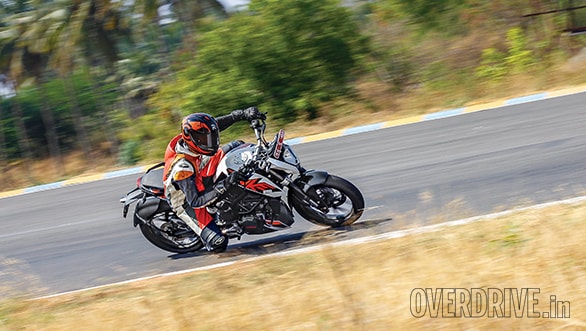 Nestled in the Duke's rigid trellis frame is an angry motor that offers great tractability through its close ratio, six-speed gearbox. KTM brakes are usually a weak point but this unit surprised with strong and consistent performance. Underslung exhaust won't scrape like the other two but the footpegs do.
Nestled in the Duke's rigid trellis frame is an angry motor that offers great tractability through its close ratio, six-speed gearbox. KTM brakes are usually a weak point but this unit surprised with strong and consistent performance. Underslung exhaust won't scrape like the other two but the footpegs do.
The Pulsar RS200 is the stability star. It's chassis has a fluency that neither of the other two can match. This makes confidence levels high and fast corner speeds feel quite natural and come easily. The RS does have the least clearance though and it's exhaust scrapes. You do sense that the rear tyre's outright grip is just a hair less than the front MRF's in full flat out cornering. It didn't cause any issues and it comes only at a really fast pace so I'll classify it as a sensation rather than a problem.
The TVS falls somewhere in the middle. It's stable and predictable but I was surprised at how gracefully the suspension allows the bike to sit at big leans without any undue chassis movement. That TVS can manage to balance such a soft setup and such mid-corner poise is deserving of kudos. This softness should translate to good ride on the street. Like the Bajaj, the TVS will also scrape its exhaust before its pegs but this happens rarely and isn't a serious hindrance.
Corner exits
The Duke is the leader. It's sheer power, shorter gearing and weight advantage is never more obvious. The flat torque supply also means that hard exits can be managed even if you're off by a gear.
The Apache is surprisingly strong on slow and mid-speed exits. This is where the mid-range plays a role and the bike surges forward strongly. Faster speed corner exits show the relatively weak top-end though. No surprises then. We did find that the gearbox is a little more reluctant than we expected in handling rapid clutchless gearchanges. More than once we had the RTR refuse a gear change or bounce into a lower gear on the exit.
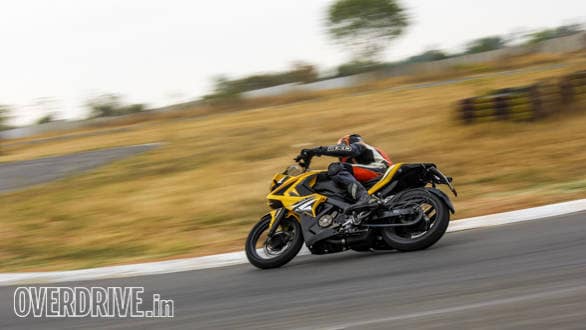
The RS200 is satisfying to drive out of corners but ultimately only just as fast as the RTR - a mere 0.68 seconds a lap. It's more progressive torque curves (versus the Duke) makes working the gearbox for maximum effect more fun. The stock MRFs also acquit themselves well in some fairly hi-po company as well - which is commendable, really.
Over the lap
The TVS surprised us by being so soft and gentle feeling but proving so effective. It handily matches the Pulsar RS200 over the full lap using lighter weight, superior tyres and better brakes to overcome its horsepower deficit. It's a smooth, friendly motorcycle that goes very hard without feeling busy or strained. The lack of top-end clearly manifests in the longer straights and faster corner exits but we cannot wait to ride the RTR in the real world. The engine tune really is a real world focussed choice TVS has made and it should be quite something in traffic.
The RS200 is a surprise too. We knew that dynamically the motorcycle is excellent but it's stability and security is a tremendous asset. These two factors can make the RS200 feel like you're doing more work and going quite a bit slower than the Apache. But the test equipment shows that everyone who rode the Pulsar - fast guys like Anand Dharmaraj of Indimotard or slower riders - were all a second or so quicker than the RTR around the Kari Speedway.
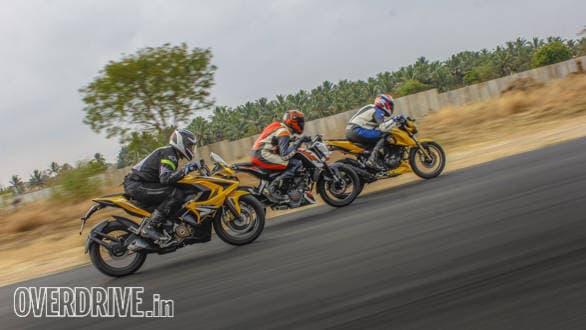
The Duke, still, is the performance king. Out on the street, it's a bit hardcore. Suspension's stiff, refinement is a bit rough and tough and the economy is the lowest of this trio by a fair margin. It isn't a universal flavour of motorcycle and it will, by its very nature, polarise opinion. But at the track, it's a phenom. It isn't as effortless as the RC200 but it's very, very sharp. It's sharp chassis, stiff setup, lack of weight (perceived and actual) and intense feedback give it a shiny edge that makes it uncatcheable in this company.
Verdict
TVS have a very, very good motorcycle in the RTR 200 4V. We've still not been able to get a motorcycle for a road test out in the world but the promise is huge. We expected the heavily street-oriented setup and the lack of top-end punch over the RS200 to cost the TVS at the track. But the engineers have managed an astonishing blend of everyday ride quality and engine tune with an accurate and rapid motorcycle. Most RTR buyers will never go to a track, it's true, but if they did they wouldn't be disappointed. That said, we must also note that Kari is a stop and go track with very few fast corner exits and the RTR would be at a greater disadvantage at faster, more flowing MMRT, Chennai or the BIC.
The RS200 is the best Pulsar. No doubts there. It's a really likeable, trustworthy motorcycle that stays in character as you up the pace - excellent. Ultimately it's a bit faster overall than the TVS, well done Bajaj!
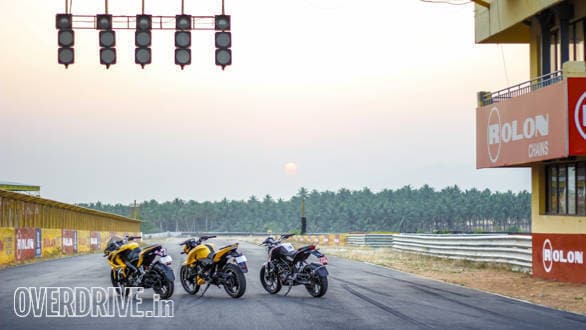 LAP TIMES: TVS Apache RTR 200 4V: 1m 25.13s KTM 200 Duke: 1m 22.13s Bajaj Pulsar RS 200: 1m 24.45s
LAP TIMES: TVS Apache RTR 200 4V: 1m 25.13s KTM 200 Duke: 1m 22.13s Bajaj Pulsar RS 200: 1m 24.45s
The KTM is really a step forward for the class. It's abilities are very clearly defined and some aspects (like comfort) are compromised for these abilities to shine. It's unquestionably the fastest around the track and performance enthusiasts who like the peculiarly specific flavour of the KTM should just go get one.
For everyone else, TVS has a credible, surprisingly gentle and comfy alternative now. Add in the Rs 15,000-odd advantage (to the non-ABS RS200) in pricing and the TVS RTR 200 4V looks even better!
LAP TIMES:
TVS Apache RTR 200 4V: 1m 25.13s
KTM 200 Duke: 1m 22.13s
Bajaj Pulsar RS 200: 1m 24.45s

Images by Anis Shaikh
